Financial Accounting 2 - Ratio Analysis & Company Comparison
VerifiedAdded on 2022/08/27
|6
|1464
|19
Homework Assignment
AI Summary
This financial accounting assignment analyzes key financial ratios, including the price-earnings ratio (P-E), return on common shareholders' equity, return on assets (ROA), and dividend yield. The assignment defines these terms and explains their significance in assessing a company's financial health and investment potential. It explores why a software company might have a higher P-E ratio and lower returns compared to a bank, and why a bank might offer a dividend yield while a software company might not. The analysis delves into the differing financial structures of banks and software companies, explaining why banks often have a large difference between return on equity and return on assets. Finally, the assignment concludes with a personal investment decision based on the financial analysis and the reasoning behind it, favoring a bank over a software company for its stable income and dividend yield.
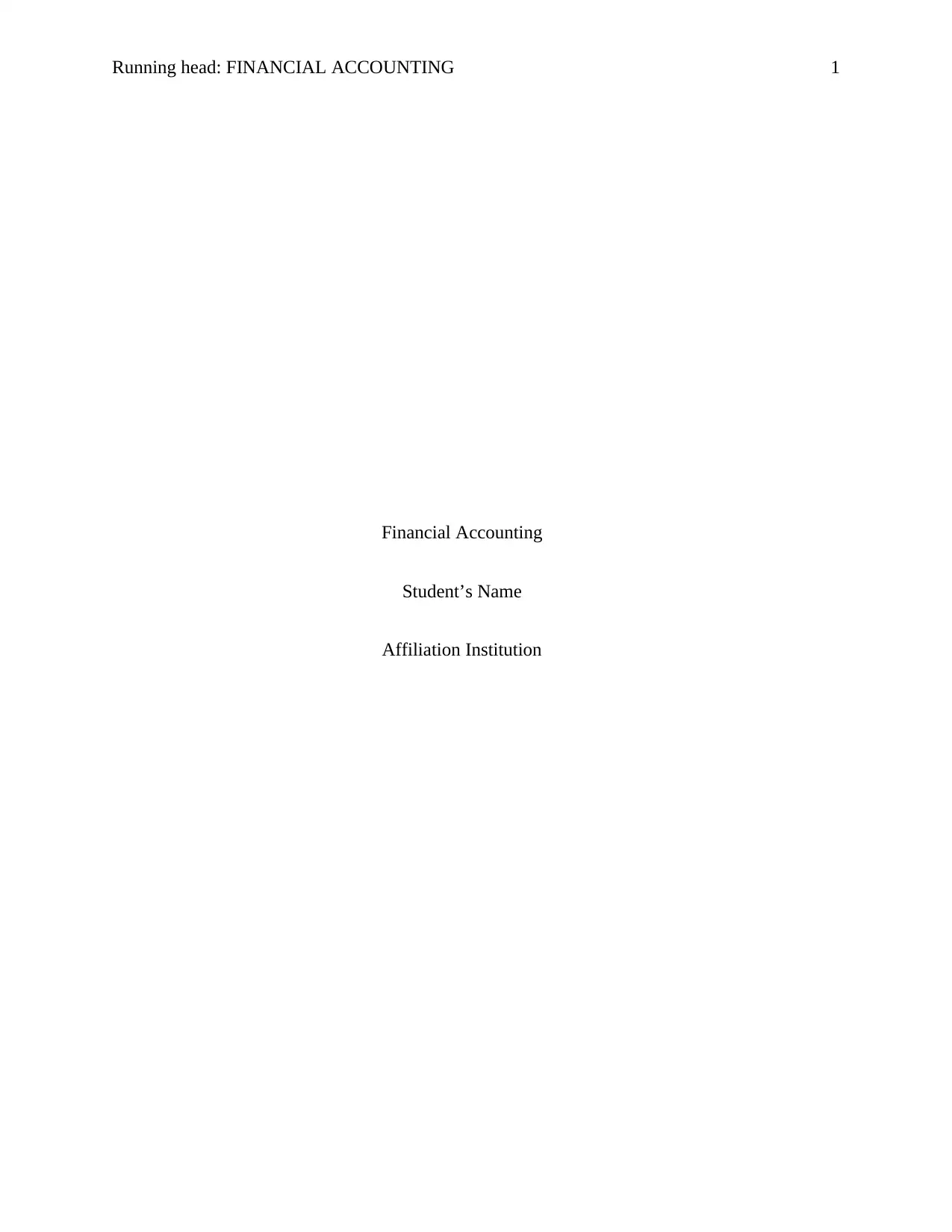
Running head: FINANCIAL ACCOUNTING 1
Financial Accounting
Student’s Name
Affiliation Institution
Financial Accounting
Student’s Name
Affiliation Institution
Paraphrase This Document
Need a fresh take? Get an instant paraphrase of this document with our AI Paraphraser
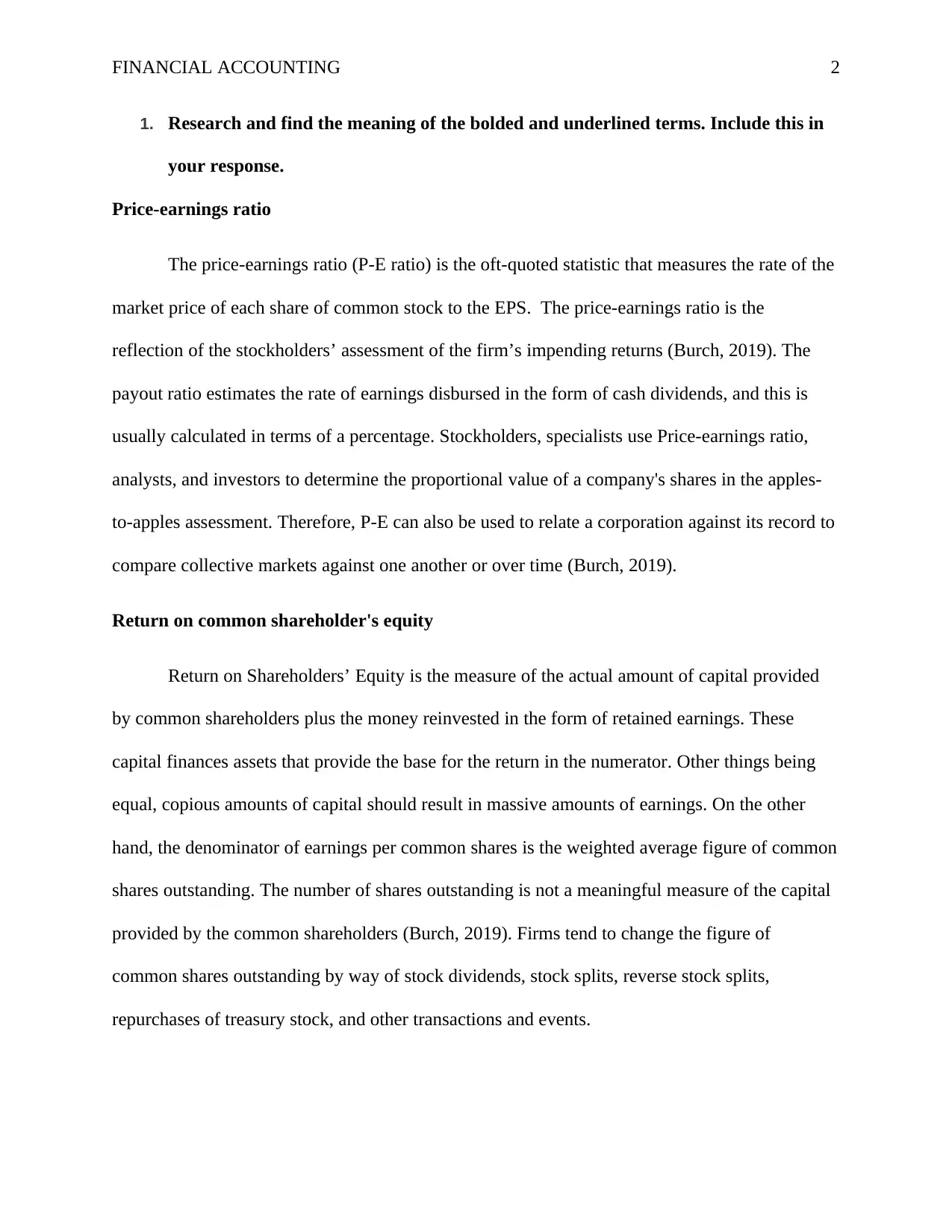
FINANCIAL ACCOUNTING 2
1. Research and find the meaning of the bolded and underlined terms. Include this in
your response.
Price-earnings ratio
The price-earnings ratio (P-E ratio) is the oft-quoted statistic that measures the rate of the
market price of each share of common stock to the EPS. The price-earnings ratio is the
reflection of the stockholders’ assessment of the firm’s impending returns (Burch, 2019). The
payout ratio estimates the rate of earnings disbursed in the form of cash dividends, and this is
usually calculated in terms of a percentage. Stockholders, specialists use Price-earnings ratio,
analysts, and investors to determine the proportional value of a company's shares in the apples-
to-apples assessment. Therefore, P-E can also be used to relate a corporation against its record to
compare collective markets against one another or over time (Burch, 2019).
Return on common shareholder's equity
Return on Shareholders’ Equity is the measure of the actual amount of capital provided
by common shareholders plus the money reinvested in the form of retained earnings. These
capital finances assets that provide the base for the return in the numerator. Other things being
equal, copious amounts of capital should result in massive amounts of earnings. On the other
hand, the denominator of earnings per common shares is the weighted average figure of common
shares outstanding. The number of shares outstanding is not a meaningful measure of the capital
provided by the common shareholders (Burch, 2019). Firms tend to change the figure of
common shares outstanding by way of stock dividends, stock splits, reverse stock splits,
repurchases of treasury stock, and other transactions and events.
1. Research and find the meaning of the bolded and underlined terms. Include this in
your response.
Price-earnings ratio
The price-earnings ratio (P-E ratio) is the oft-quoted statistic that measures the rate of the
market price of each share of common stock to the EPS. The price-earnings ratio is the
reflection of the stockholders’ assessment of the firm’s impending returns (Burch, 2019). The
payout ratio estimates the rate of earnings disbursed in the form of cash dividends, and this is
usually calculated in terms of a percentage. Stockholders, specialists use Price-earnings ratio,
analysts, and investors to determine the proportional value of a company's shares in the apples-
to-apples assessment. Therefore, P-E can also be used to relate a corporation against its record to
compare collective markets against one another or over time (Burch, 2019).
Return on common shareholder's equity
Return on Shareholders’ Equity is the measure of the actual amount of capital provided
by common shareholders plus the money reinvested in the form of retained earnings. These
capital finances assets that provide the base for the return in the numerator. Other things being
equal, copious amounts of capital should result in massive amounts of earnings. On the other
hand, the denominator of earnings per common shares is the weighted average figure of common
shares outstanding. The number of shares outstanding is not a meaningful measure of the capital
provided by the common shareholders (Burch, 2019). Firms tend to change the figure of
common shares outstanding by way of stock dividends, stock splits, reverse stock splits,
repurchases of treasury stock, and other transactions and events.
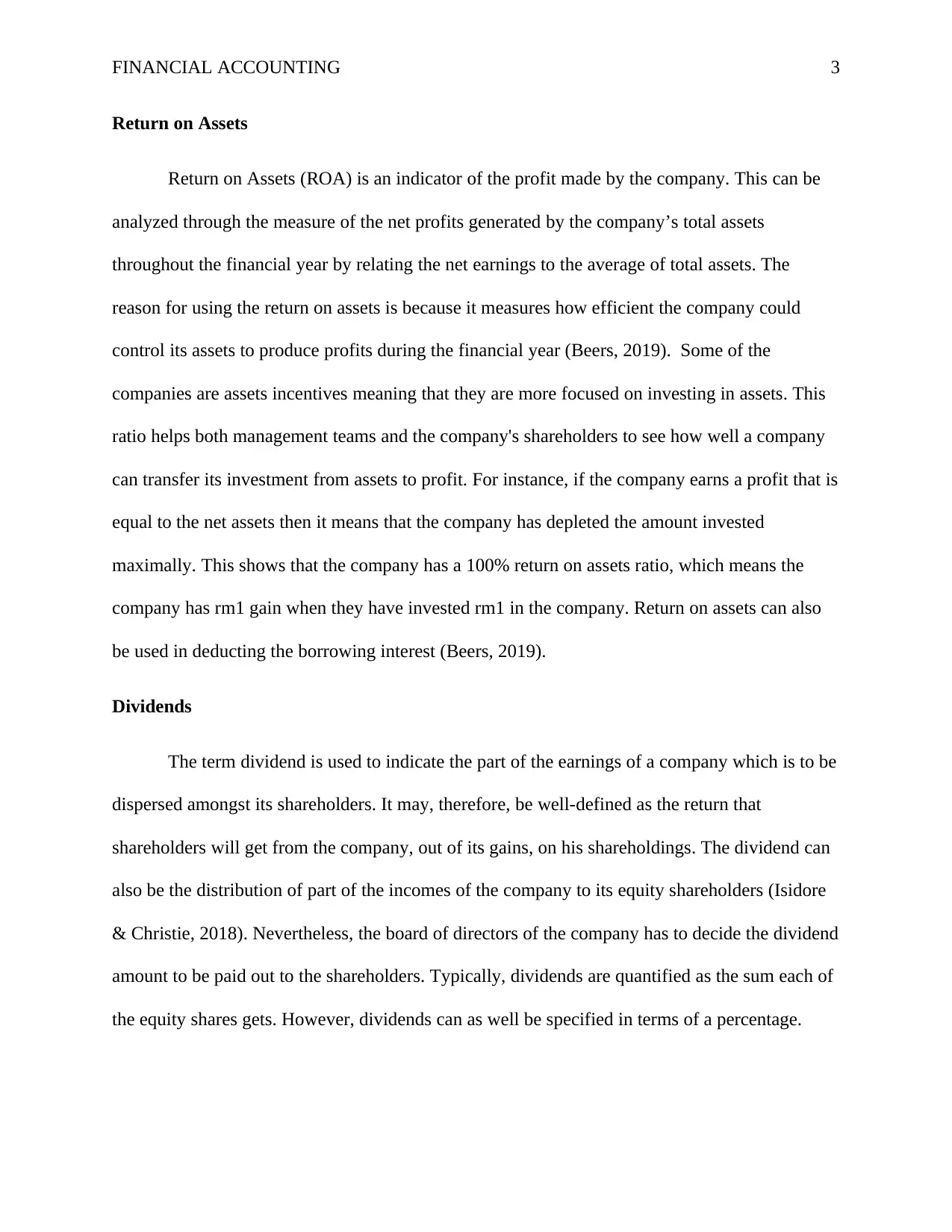
FINANCIAL ACCOUNTING 3
Return on Assets
Return on Assets (ROA) is an indicator of the profit made by the company. This can be
analyzed through the measure of the net profits generated by the company’s total assets
throughout the financial year by relating the net earnings to the average of total assets. The
reason for using the return on assets is because it measures how efficient the company could
control its assets to produce profits during the financial year (Beers, 2019). Some of the
companies are assets incentives meaning that they are more focused on investing in assets. This
ratio helps both management teams and the company's shareholders to see how well a company
can transfer its investment from assets to profit. For instance, if the company earns a profit that is
equal to the net assets then it means that the company has depleted the amount invested
maximally. This shows that the company has a 100% return on assets ratio, which means the
company has rm1 gain when they have invested rm1 in the company. Return on assets can also
be used in deducting the borrowing interest (Beers, 2019).
Dividends
The term dividend is used to indicate the part of the earnings of a company which is to be
dispersed amongst its shareholders. It may, therefore, be well-defined as the return that
shareholders will get from the company, out of its gains, on his shareholdings. The dividend can
also be the distribution of part of the incomes of the company to its equity shareholders (Isidore
& Christie, 2018). Nevertheless, the board of directors of the company has to decide the dividend
amount to be paid out to the shareholders. Typically, dividends are quantified as the sum each of
the equity shares gets. However, dividends can as well be specified in terms of a percentage.
Return on Assets
Return on Assets (ROA) is an indicator of the profit made by the company. This can be
analyzed through the measure of the net profits generated by the company’s total assets
throughout the financial year by relating the net earnings to the average of total assets. The
reason for using the return on assets is because it measures how efficient the company could
control its assets to produce profits during the financial year (Beers, 2019). Some of the
companies are assets incentives meaning that they are more focused on investing in assets. This
ratio helps both management teams and the company's shareholders to see how well a company
can transfer its investment from assets to profit. For instance, if the company earns a profit that is
equal to the net assets then it means that the company has depleted the amount invested
maximally. This shows that the company has a 100% return on assets ratio, which means the
company has rm1 gain when they have invested rm1 in the company. Return on assets can also
be used in deducting the borrowing interest (Beers, 2019).
Dividends
The term dividend is used to indicate the part of the earnings of a company which is to be
dispersed amongst its shareholders. It may, therefore, be well-defined as the return that
shareholders will get from the company, out of its gains, on his shareholdings. The dividend can
also be the distribution of part of the incomes of the company to its equity shareholders (Isidore
& Christie, 2018). Nevertheless, the board of directors of the company has to decide the dividend
amount to be paid out to the shareholders. Typically, dividends are quantified as the sum each of
the equity shares gets. However, dividends can as well be specified in terms of a percentage.
⊘ This is a preview!⊘
Do you want full access?
Subscribe today to unlock all pages.

Trusted by 1+ million students worldwide
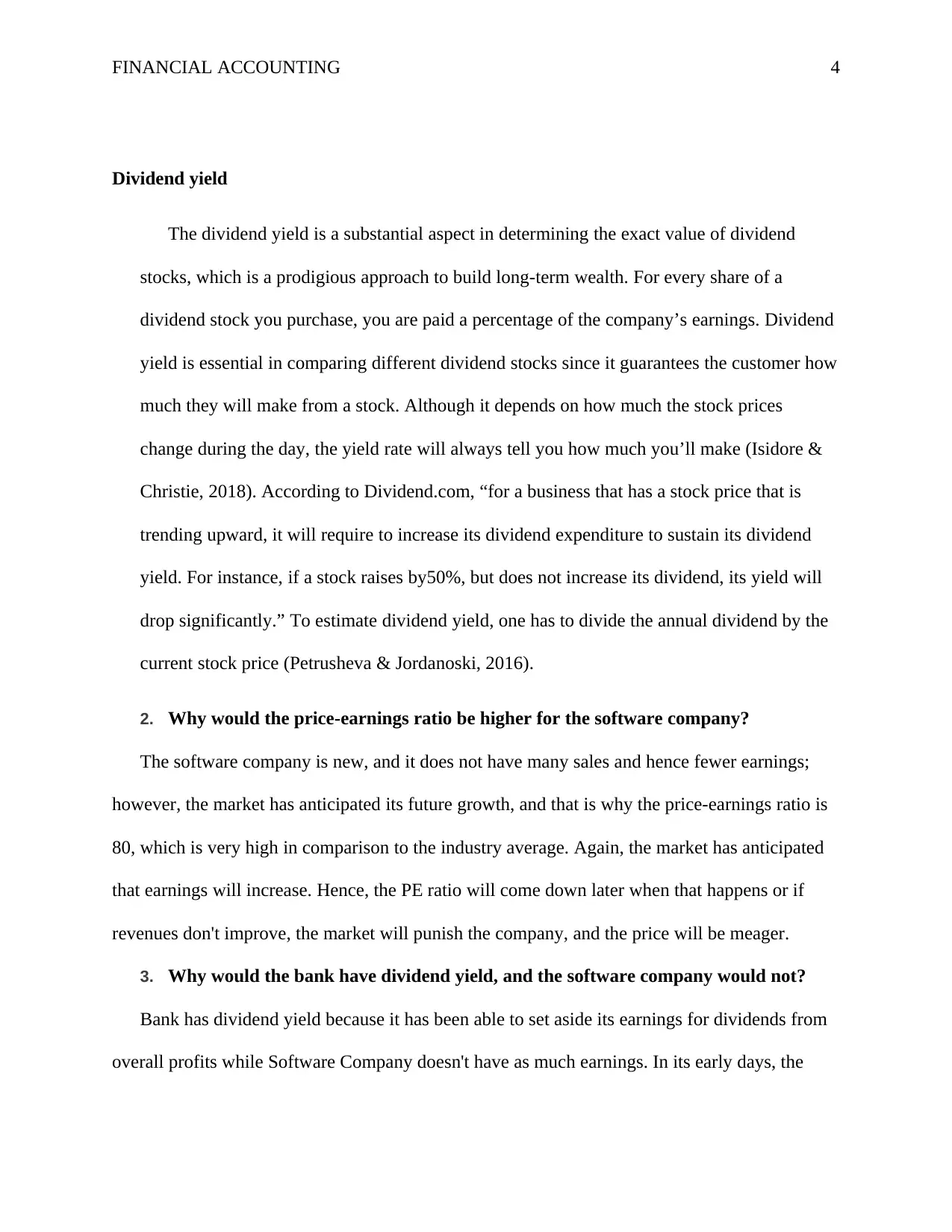
FINANCIAL ACCOUNTING 4
Dividend yield
The dividend yield is a substantial aspect in determining the exact value of dividend
stocks, which is a prodigious approach to build long-term wealth. For every share of a
dividend stock you purchase, you are paid a percentage of the company’s earnings. Dividend
yield is essential in comparing different dividend stocks since it guarantees the customer how
much they will make from a stock. Although it depends on how much the stock prices
change during the day, the yield rate will always tell you how much you’ll make (Isidore &
Christie, 2018). According to Dividend.com, “for a business that has a stock price that is
trending upward, it will require to increase its dividend expenditure to sustain its dividend
yield. For instance, if a stock raises by50%, but does not increase its dividend, its yield will
drop significantly.” To estimate dividend yield, one has to divide the annual dividend by the
current stock price (Petrusheva & Jordanoski, 2016).
2. Why would the price-earnings ratio be higher for the software company?
The software company is new, and it does not have many sales and hence fewer earnings;
however, the market has anticipated its future growth, and that is why the price-earnings ratio is
80, which is very high in comparison to the industry average. Again, the market has anticipated
that earnings will increase. Hence, the PE ratio will come down later when that happens or if
revenues don't improve, the market will punish the company, and the price will be meager.
3. Why would the bank have dividend yield, and the software company would not?
Bank has dividend yield because it has been able to set aside its earnings for dividends from
overall profits while Software Company doesn't have as much earnings. In its early days, the
Dividend yield
The dividend yield is a substantial aspect in determining the exact value of dividend
stocks, which is a prodigious approach to build long-term wealth. For every share of a
dividend stock you purchase, you are paid a percentage of the company’s earnings. Dividend
yield is essential in comparing different dividend stocks since it guarantees the customer how
much they will make from a stock. Although it depends on how much the stock prices
change during the day, the yield rate will always tell you how much you’ll make (Isidore &
Christie, 2018). According to Dividend.com, “for a business that has a stock price that is
trending upward, it will require to increase its dividend expenditure to sustain its dividend
yield. For instance, if a stock raises by50%, but does not increase its dividend, its yield will
drop significantly.” To estimate dividend yield, one has to divide the annual dividend by the
current stock price (Petrusheva & Jordanoski, 2016).
2. Why would the price-earnings ratio be higher for the software company?
The software company is new, and it does not have many sales and hence fewer earnings;
however, the market has anticipated its future growth, and that is why the price-earnings ratio is
80, which is very high in comparison to the industry average. Again, the market has anticipated
that earnings will increase. Hence, the PE ratio will come down later when that happens or if
revenues don't improve, the market will punish the company, and the price will be meager.
3. Why would the bank have dividend yield, and the software company would not?
Bank has dividend yield because it has been able to set aside its earnings for dividends from
overall profits while Software Company doesn't have as much earnings. In its early days, the
Paraphrase This Document
Need a fresh take? Get an instant paraphrase of this document with our AI Paraphraser
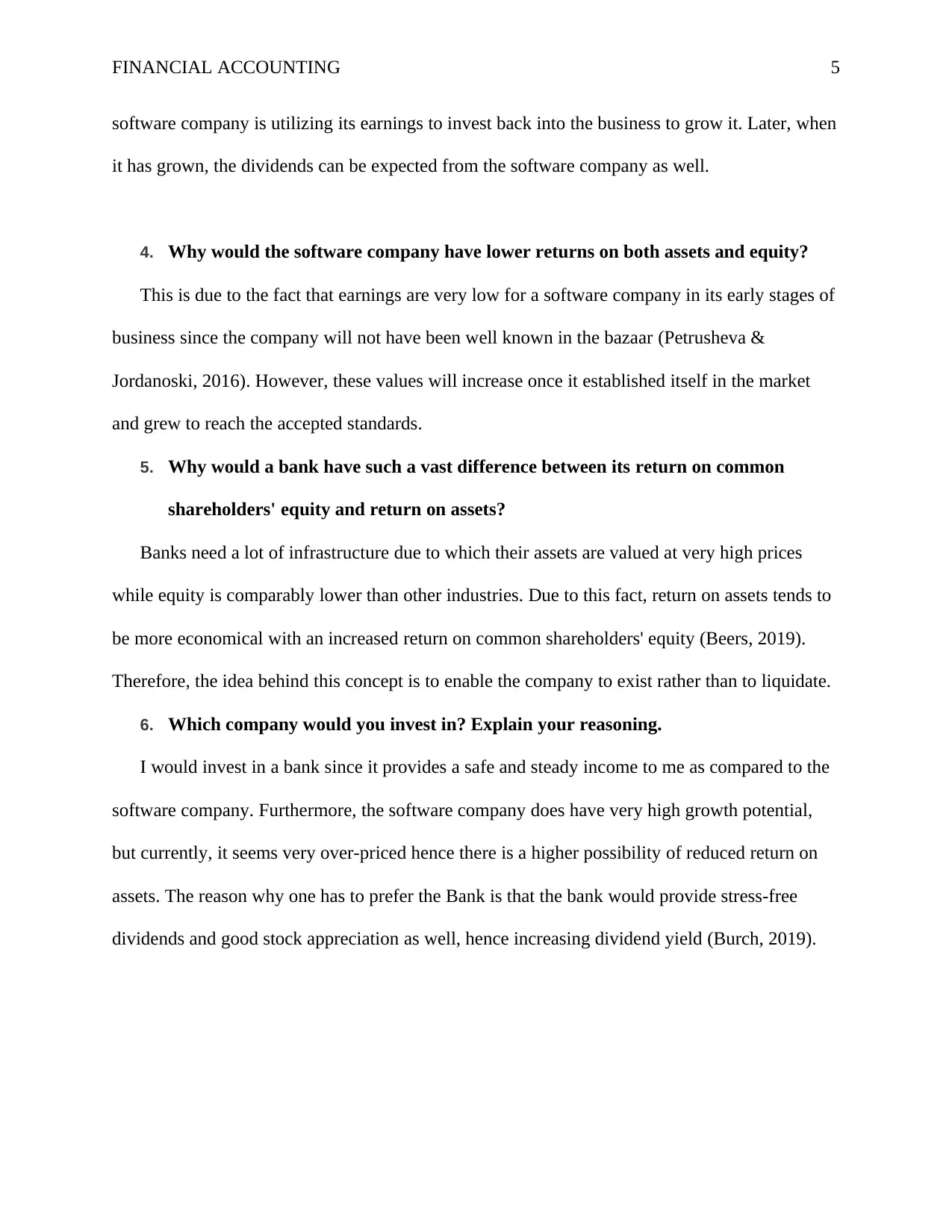
FINANCIAL ACCOUNTING 5
software company is utilizing its earnings to invest back into the business to grow it. Later, when
it has grown, the dividends can be expected from the software company as well.
4. Why would the software company have lower returns on both assets and equity?
This is due to the fact that earnings are very low for a software company in its early stages of
business since the company will not have been well known in the bazaar (Petrusheva &
Jordanoski, 2016). However, these values will increase once it established itself in the market
and grew to reach the accepted standards.
5. Why would a bank have such a vast difference between its return on common
shareholders' equity and return on assets?
Banks need a lot of infrastructure due to which their assets are valued at very high prices
while equity is comparably lower than other industries. Due to this fact, return on assets tends to
be more economical with an increased return on common shareholders' equity (Beers, 2019).
Therefore, the idea behind this concept is to enable the company to exist rather than to liquidate.
6. Which company would you invest in? Explain your reasoning.
I would invest in a bank since it provides a safe and steady income to me as compared to the
software company. Furthermore, the software company does have very high growth potential,
but currently, it seems very over-priced hence there is a higher possibility of reduced return on
assets. The reason why one has to prefer the Bank is that the bank would provide stress-free
dividends and good stock appreciation as well, hence increasing dividend yield (Burch, 2019).
software company is utilizing its earnings to invest back into the business to grow it. Later, when
it has grown, the dividends can be expected from the software company as well.
4. Why would the software company have lower returns on both assets and equity?
This is due to the fact that earnings are very low for a software company in its early stages of
business since the company will not have been well known in the bazaar (Petrusheva &
Jordanoski, 2016). However, these values will increase once it established itself in the market
and grew to reach the accepted standards.
5. Why would a bank have such a vast difference between its return on common
shareholders' equity and return on assets?
Banks need a lot of infrastructure due to which their assets are valued at very high prices
while equity is comparably lower than other industries. Due to this fact, return on assets tends to
be more economical with an increased return on common shareholders' equity (Beers, 2019).
Therefore, the idea behind this concept is to enable the company to exist rather than to liquidate.
6. Which company would you invest in? Explain your reasoning.
I would invest in a bank since it provides a safe and steady income to me as compared to the
software company. Furthermore, the software company does have very high growth potential,
but currently, it seems very over-priced hence there is a higher possibility of reduced return on
assets. The reason why one has to prefer the Bank is that the bank would provide stress-free
dividends and good stock appreciation as well, hence increasing dividend yield (Burch, 2019).
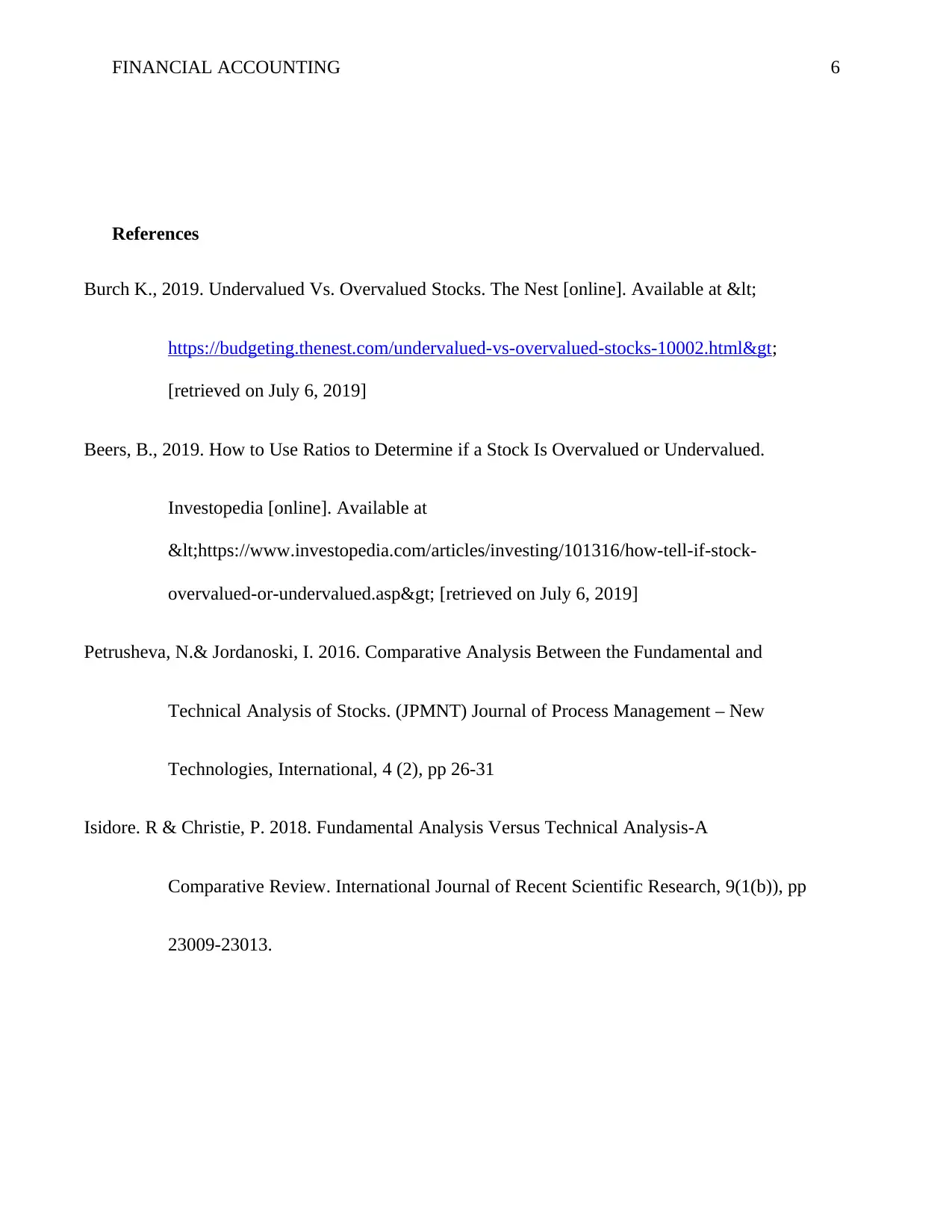
FINANCIAL ACCOUNTING 6
References
Burch K., 2019. Undervalued Vs. Overvalued Stocks. The Nest [online]. Available at <
https://budgeting.thenest.com/undervalued-vs-overvalued-stocks-10002.html>
[retrieved on July 6, 2019]
Beers, B., 2019. How to Use Ratios to Determine if a Stock Is Overvalued or Undervalued.
Investopedia [online]. Available at
<https://www.investopedia.com/articles/investing/101316/how-tell-if-stock-
overvalued-or-undervalued.asp> [retrieved on July 6, 2019]
Petrusheva, N.& Jordanoski, I. 2016. Comparative Analysis Between the Fundamental and
Technical Analysis of Stocks. (JPMNT) Journal of Process Management – New
Technologies, International, 4 (2), pp 26-31
Isidore. R & Christie, P. 2018. Fundamental Analysis Versus Technical Analysis-A
Comparative Review. International Journal of Recent Scientific Research, 9(1(b)), pp
23009-23013.
References
Burch K., 2019. Undervalued Vs. Overvalued Stocks. The Nest [online]. Available at <
https://budgeting.thenest.com/undervalued-vs-overvalued-stocks-10002.html>
[retrieved on July 6, 2019]
Beers, B., 2019. How to Use Ratios to Determine if a Stock Is Overvalued or Undervalued.
Investopedia [online]. Available at
<https://www.investopedia.com/articles/investing/101316/how-tell-if-stock-
overvalued-or-undervalued.asp> [retrieved on July 6, 2019]
Petrusheva, N.& Jordanoski, I. 2016. Comparative Analysis Between the Fundamental and
Technical Analysis of Stocks. (JPMNT) Journal of Process Management – New
Technologies, International, 4 (2), pp 26-31
Isidore. R & Christie, P. 2018. Fundamental Analysis Versus Technical Analysis-A
Comparative Review. International Journal of Recent Scientific Research, 9(1(b)), pp
23009-23013.
⊘ This is a preview!⊘
Do you want full access?
Subscribe today to unlock all pages.

Trusted by 1+ million students worldwide
1 out of 6
Related Documents
Your All-in-One AI-Powered Toolkit for Academic Success.
+13062052269
info@desklib.com
Available 24*7 on WhatsApp / Email
![[object Object]](/_next/static/media/star-bottom.7253800d.svg)
Unlock your academic potential
Copyright © 2020–2025 A2Z Services. All Rights Reserved. Developed and managed by ZUCOL.




